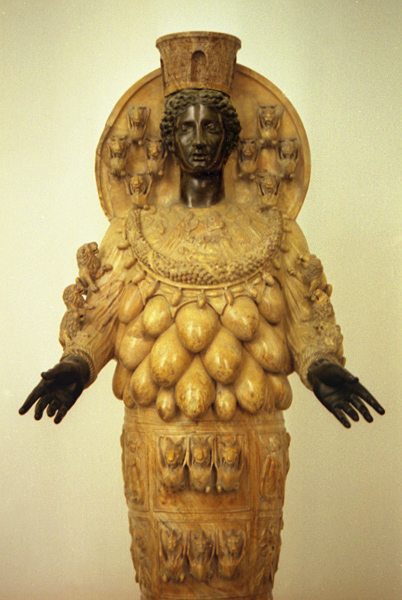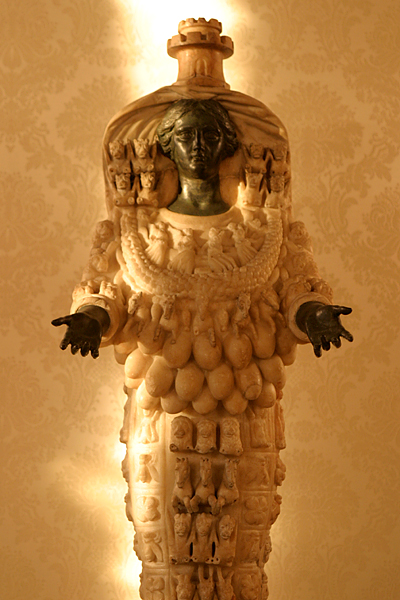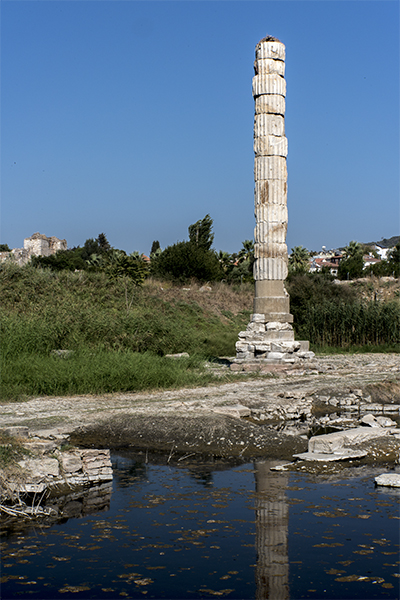"I have set eyes on the wall of lofty Babylon on which is a road for chariots, and the statue of Zeus by the Alpheus, and the hanging gardens, and the colossus of the Sun, and the huge labour of the high pyramids, and the vast tomb of Mausolus; but when I saw the house of Artemis that mounted to the clouds, those other marvels lost their brilliancy, and I said, 'Lo, apart from Olympus, the Sun never looked on aught so grand.'"
Antipater of Sidon, Greek Anthology (IX.58)
Designed by the architect Chersiphron, with many of the Ionic columns erected at the expense of Croesus (Herodotus, The Histories, I.92), the fabulously wealthy king of Lydia (ruled 560–546 BC), the Temple of Artemis (Artemisium) at Ephesus was the first to be entirely of marble and one of the largest Greek temples ever built, measuring some 377 feet in length and 180 feet wide (larger by twenty feet on a side than a football field). It was constructed on marshy ground so as not to be in danger from earthquakes, and the foundation laid on a bed of packed charcoal and sheepskins (Pliny, Natural History, XXXVI. 21). The huge column drums and architraves were moved from the quarry by fitting them with large wheels and then, like rolling axles, pulled by oxen (Vitruvius, On Architecture, X.2.11–12).
Pliny goes on to say that the temple had 127 columns, each sixty feet high. Vitruvius (III.2.7) describes it as dipteral octastyle, that is, two rows of columns around the temple with eight on the front and rear façades. The few scattered artifacts, however, do not reveal a ground plan. One arrangement of the requisite number of columns is to have a double row of twenty-one along the sides, three rows of eight columns on the principle façade, two rows of nine columns at the rear, and the remainder filling the pronaos and opisthodomos (the front and back porches). Thirty-six of these columns, says Pliny, were carved with reliefs, one of them by Scopas, who also worked on the Mausoleum at Halicarnassus.
The temple had taken one-hundred twenty years to complete. A variant reading indicates two hundred years, which is the approximate time from when construction of the temple began (about 560 BC) to its destruction in 356 BC. On the night when Alexander the Great was said to have been born, the temple was deliberately burned down by Herostratus, who, setting fire to the wooden frame of the roof, hoped to immortalize his name. Artemis, herself, was said by Plutarch (III.5-6) to have been absent from the shrine, assisting in the delivery of Alexander. The story of this infamous act is related by Valerius Maximus (Memorable Doings and Sayings, VIII.14.5), where he says that "A man was found to plan the burning of the temple of Ephesian Diana so that through the destruction of this most beautiful building his name might be spread through the whole world." The Ephesians, however, decreed that his name never be recorded (Aulus Gellius, Attic Nights, II.6.18), and it would not be known had not Strabo (Geography, XIV.1.22) revealed it (to be sure, the name had been preserved earlier but in a work now lost).
Although rebuilding on the original foundation soon began, the temple still was unfinished when Alexander the Great liberated Ephesus in 334 BC and offered to pay all its expenses, if he were to have credit for his generosity, but Strabo relates that the offer was refused by the Ephesians, who diplomatically said that "it was inappropriate for a god to dedicate offerings to gods" (XIV.1.22).
Weakened by earthquakes (in spite of its location on marshy ground) and burned by the Goths in AD 262 (Jordanes, Gothic History, XX.107), the ruins of the temple were used as a quarry for building the Byzantine city at Ephesus. What remnants survived would have been burned for lime and the rest allowed to slowly silt up beneath alluvial deposits. When Theodosius I closed the temples in AD 391, the Artemision already must have been in a ruinous state.
But even while the Artemision still was standing, there was exultation in its imagined destruction. The apocryphal Acts of John is a second-century Christian account of the apostle's visit to Ephesus that, although dismissed by Eusebius as belonging to "the fictions of heretics...to be cast aside as absurd and impious" (Ecclesiastical History, III.25.7), is filled with wondrous tales. Threatening the population with death, he then prayed for God's mercy that the deceived multitude might be shown their error. "And as John spake these things, immediately the altar of Artemis was parted into many pieces, and all the things that were dedicated in the temple fell, and was rent asunder, and likewise of the images of the gods more than seven. And the half of the temple fell down, so that the priest was slain at one blow by the falling of the <roof>" (XLII).
A more dramatic account is related in the Syriac History of John, the Son of Zebedee, the Apostle and Evangelist.
"We renounce this Artemis, in whom there is no use...And they were beating their faces and saying: 'Alas, what has befallen us? for our possessions have been consumed in libations, and we have gained loss for our souls.' And the priests said: 'Ye are men of sense; whatever is good in your eyes, do; but we will worship and honour Him who is able to make alive and to destroy.' And they ran down from the altar, and with speed went up to the holy (man) [John], and cast themselves upon their faces before the holy (man). And the whole crowd cast cords about the image of Artemis, and pulled it down, and dragged it along, while bands were crying out before it and behind it: 'Thou destroyer of our lives, arise, deliver thyself! Not from heaven didst thou descend; artisans made thee in a furnace'" (Wright, p. 46).
By the beginning of the fifth century AD, however, the Temple of Artemis surely was destroyed. In about AD 402, Prudentius writes that "the huntress maid resigned Ephesus to thee [Christ]" (Against Symmachus, II.495). Another Christian poet, Paulinus of Nola, says much the same thing a few years later, in January AD 405: "Diana, too, has fled from Ephesus, for John has thrust her out" (Poem XIX.95). Paulinus is referring to John the Apostle, but there was another of the same name who also was charged with the destruction of the Artemision: John Chrysostom, Archbishop of Constantinople from AD 397 to 403, who was given the epithet "golden mouthed" for his rhetorical ability.
Ironically, it had been learned from his pagan teacher Libanius, who wrote an poignant plea to Theodosius for the preservation of the ancient temples then being destroyed. Even though the emperor has "not ordered the temples to be shut up, nor forbidden any to frequent them: nor have you driven from the temples or the altars, fire or frankincense, or other honours of incense," monks run to them, "bringing with them wood, and stones, and iron, and when they have not these, hands and feet....the roofs are uncovered, walls are pulled down, images are carried off, and altars are overturned: the priests all the while must be silent upon pain of death. When they have destroyed one temple they run to another, and a third, and trophies are erected upon trophies: which are all contrary to law. This is the practice in cities, but especially in the countries" (Oration XXX, Pro Templis).
Cyril of Alexandria accuses John Chrysostom of having destroyed the Artemision in an encomium on the Virgin, where he refers to him as "the destroyer of the demons and overthrower of the temple of Diana" (Homily XI, from Patrologia Graeca, LXXVII, col. 1031). Although this homily is considered to be spurious, Proclus of Constantinople, Archbishop of Constantinople who died in AD 446, in lauding the achievements of John, does comment that "In Ephesus, he despoiled the art of Midas" (Oration XX.3, from Patrologia Graeca, LXV, col. 832). He also encouraged the depredation of other temples.
"On receiving information that Phœnicia was still suffering from the madness of the demons' rites, John got together certain monks who were fired with divine zeal, armed them with imperial edicts and dispatched them against the idols' shrines. The money which was required to pay the craftsmen and their assistants who were engaged in the work of destruction was not taken by John from imperial resources, but he persuaded certain wealthy and faithful women to make liberal contributions, pointing out to them how great would be the blessing their generosity would win" (Theodoret, Ecclesiastical History, V.29).
"The arts of Greece, and the wealth of Asia, had conspired to erect that sacred and magnificent structure....The temple of Diana was, however, admired as one of the wonders of the world. Successive empires, the Persian, the Macedonian, and the Roman, had revered its sanctity, and enriched its splendour. But the rude savages of the Baltic were destitute of a taste for the elegant arts, and they despised the ideal terrors of a foreign superstition."
Edward Gibbon, Decline and Fall of the Roman Empire (I.10.3)
Only a single forlorn column of the Artemisium now remains, assembled in 1972 from scattered drums excavated at the site where it stood. To imagine how it must once have appeared, one must look to the nearby Temple of Apollo, the twin brother of Artemis, at Didyma.
"Then they [the Amazons] turned to Ionia and Aeolia, and made provinces of them after their surrender. Here they ruled for some time and even founded cities and camps bearing their name. At Ephesus also they built a very costly and beautiful temple for Diana, because of her delight in archery and the chase—arts to which they were themselves devoted."
Jordanes, The Origin and Deeds of the Goths (VII.51)
Ephesus was thought to have been founded by the Amazons and their statues, chosen from a competition among the most celebrated artists of the day, were dedicated at the completion of the Temple of Artemis about 440–430 BC. Roman copies of these lost bronze originals each show the figure of the same size and dress, with the right arm raised over her head, sometimes leaning on a spear.


So different from the Roman image of Diana, with whom Artemis was associated, this second-century AD statue (on the left), which is the best example of the Ephesian cult statue, is in the National Archaeological Museum of Naples. Fashioned in alabaster and bronze, the breasts (or possibly eggs or the testicles of sacrificial bulls) symbolize the fruitfulness and bounty of nature, as does the modius (a grain measure) on her head. The statue on the right, made more radiant still by the late afternoon sun streaming through the window, is in the Museo del Palazzo dei Conservatori (Rome).

Obv. TI CLAVD CAES AVG bare head of Claudius left; Rev. DIAN EPHE, Statue of Diana of Ephesus standing facing within a tetrastyle temple. Reference: RIC I 118, BMC 229, RSC 30
This silver cistophoric tetradrachm is from the early reign of Claudius. Issued in Asia, it depicts the decorated tympanum of the temple pediment, which was pierced by three openings or windows that allowed light to enter the temple and so illuminate the goddess (and which also relieved pressure on the architrave). The figures shown on the pediment between the openings may be bronze statues of the Amazons.
The pediment exists only in fragments. But there was another Temple of Artemis at nearby Magnesia on the Meander, and a coin issued there by Hadrian shows similar rectangles. The frames and cornices of those openings confirm that the same openings must have appeared on the temple at Ephesus. It is numismatic evidence such as this that provides the means to reconstruct such architectural features.
In AD 57, the apostle Paul was obliged to leave Ephesus.
"About that time no little disturbance broke out concerning the Way. For a man named Demetrius, a silversmith, who made silver shrines of Artemis, brought no little business to the craftsmen. These he gathered together, with the workermen of like occupation, and said, 'Men, you know that from this business we have our wealth. And you see and hear that not only at Ephesus but almost throughout all Asia this Paul has persuaded and turned away a considerable number of people, saying that gods made with hands are not gods. And there is danger not only that this trade of ours may come into disrepute but also that the temple of the great goddess Artemis may count for nothing, and that she may even be deposed from her magnificence, she whom all Asia and the world worship.' When they heard this they were enraged and cried out, 'Great is Artemis of the Ephesians!' So the city was filled with the confusion; and they rushed together into the theater....for about two hours they all with one voice cried out, 'Great is Artemis of the Ephesians!' And when the town clerk had quieted the crowd, he said, 'Men of Ephesus, what man is there who does not know that the city of the Ephesians is temple keeper of the great Artemis, and of the sacred stone that fell from the sky?'"
Acts of the Apostles, 19:23–29, 34–35

The monumental base (top) is from the later Temple of Artemis (325–300 BC) and now in the British Museum, together with other architectural elements that were discovered there. On the last day of 1869, after a six-year search eventually funded by the British Museum, the pavement of the temple was located, twenty feet below the surface of the marshy ground, by John Turtle Wood. It was found that purchasing the land was more economical than to dig there and pay compensation, and work continued for another five years, with the discovery of the massive column drum in September 1871. Weighing more than eleven tons, it was found upside down almost entirely under water. Wood eventually was able to right the column, place supporting timbers beneath it, and winch the block to higher ground, where it was placed on a sledge—but not before ropes broke and the roadway itself gave way under the enormous weight. After nearly two months of effort, the marble finally was packed and made ready early the next year for shipment to the Museum, where it was conveyed by twenty dray horses.
The marble drum, which measures approximately six feet by six feet, depicts a draped woman tentatively identified as Alcestis (wife of Admetus, who chose to die in his stead) or Eurydice (wife of Orpheus, who led her back from Hades) and Hermes Psychopompus, holding a caduceus, who guided the shades of the dead to the underworld. A winged Thanatos (Death) is depicted on the left and on the right, Persephone and Plouton, rulers of the underworld. One of the thirty-six column drums, relates Pliny, was carved by Scopas, although it would be a remarkable coincidence if this particular drum was his work.
The temple façade (above) is a reconstruction by Lethaby.
References: Pliny: Natural History (1938-) translated by H. Rackham et al. (Loeb Classical Library); Vitruvius: The Ten Books on Architecture (1960) translated by Morris Morgan; Greek Anthology (IX: The Declamatory Epigrams) (1917) translated by W. R. Paton (Loeb Classical Library); Valerius Maximus: Memorable Doings and Sayings (2000) translated by D. R. Shackleton Bailey (Loeb Classical Library); The Geography of Strabo (1929) translated by Horace Leonard Jones (Loeb Classical Library); Aulus Gellius: Attic Nights (1927) translated by John C. Rolfe (Loeb Classical Library); Edward Gibbon: The History of the Decline and Fall of the Roman Empire (1995) edited by David Womersley (Penguin Classics); Herodotus: The Histories (1954) translated by Aubrey de Sélincourt (Penguin Classics); The Gothic History of Jordanes (1915) translated by Charles Christopher Mierow; Apocryphal Acts of the Apostles, Vol. II (1871) translated by W. Wright; The Apocryphal New Testament (1924) translated by M. R. James; The Poems of St. Paulinus of Nola (1975) translated by Patricia Gerard Walsh (Ancient Christian Writers, No. 40); Prudentius (1953) translated by H. J. Thomson (Loeb Classical Library); Patrologiæ Cursus Completus: Series Græca (1857–) edited by J.-P. Migne.
The Seven Wonders of the Ancient World (1988) edited by Peter A. Clayton and Martin J. Price; The Seven Wonders of the World (1995) by John and Elizabeth Romer; The Archaeology of Greece: An Introduction (1987) by William R. Biers; Art in the Hellenic Age (1986) by J. J. Pollitt; Greek Sculpture: The Classical Period (1985) by John Boardman; Classical Numismatic Group (5/2001), Item 725624; Discoveries at Ephesus Including the Site and Remains of the Great Temple of Diana (1877) by J. T. Wood; Greek Buildings Represented by Fragments in the British Museum: I. Diana's Temple at Ephesus (1908) by W. R. Lethaby; "The Temple of Diana at Ephesus" (February 15, 1872), The Times (London), p. 6; "The Temple of Diana at Ephesus" (April 4, 1872) by J. T. Wood, The Times (London), p. 6.

